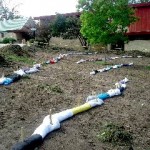
There are many ways to prepare a site for seeding with native plants. Catherine Zimmerman, in her book Urban and Suburban Meadows: Bringing Meadowscaping to Big and Small Spaces, outlines many approaches and practices that can be used. Choosing a method (or methods) of site preparation depends upon the context of the site, budget of the project, value stance on chemical herbicide use, and intended aesthetic outcome.
For The Meadow at Kansas State University, the planning team decided it was essential to kill off or remove existing cool season turf grass and weeds prior to seeding with native species. The site is a high profile location at a gateway between campus and community (just through the Beach Museum arch). While some weediness in the first few years is to be expected and will be controlled as possible through mowings and hand weeding, starting with a strong stand of native growth in the first year is the goal.
The planning team is aware of recent research on glycosophate herbicides (known by several trade names). Notably, these herbicides may be more environmentally persistent and more damaging to long term soil health than was previously thought. The planning team devoted considerable time to researching alternate methods of turf and weed removal. Kirby Barrett (Master of Landscape Architecture graduate 2011), Dr. Rhonda Janke (Horticulture, Forestry and Recreational Resources), Katie Kingery-Page and Lee Skabelund (Landscape Architecture/Regional and Community Planning), and Zakary Ratajczak (PhD student, Division of Biology) helped develop the site preparation strategy.
The result is a mixed methods approach that uses the resources available at K-State and minimizes the need for herbicides. Throughout the planning and site preparation, K-State Grounds Maintenance has been an essential partner. Jackie Toburen, Assistant Director, Facilities Services in charge of Grounds, and Joe Myers, Physical Plant Supervisor, reviewed plans for the Meadow as members of the K-State Landscape Advisory Committee. Jackie and Joe continue their work by organizing work crews to help with site preparation.
Grounds crew members, Jim Hartford and John Harper removed two unhealthy hackberry trees and trimmed dead tree limbs to make way for the new limestone path at the meadow. Jim and John also removed existing sod, hauled excess soil, and salvaged tree trunks for repurposing. Delmar Westover and Matthew Heatherly removed sod and excess soil from the site. Joe Myers, in addition to being the “how-to” orchestrator of the strategy, spot sprayed for weeds in small areas inaccessible to larger equipment.
K-State Grounds crews and equipment provide a welcome donation to the construction of the Beach Meadow, a project sponsored by the Hummel family in memory of Professor William C. Hummel and Sara T. Hummel.
Look for future posts on the planting design and maintenance plan for The Meadow!




